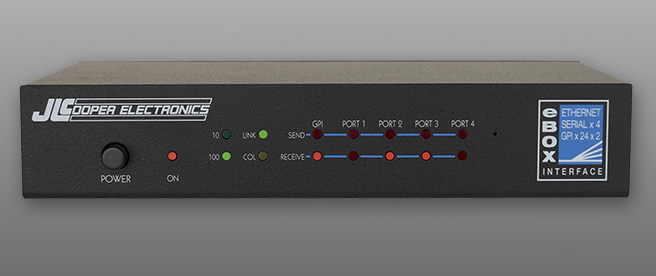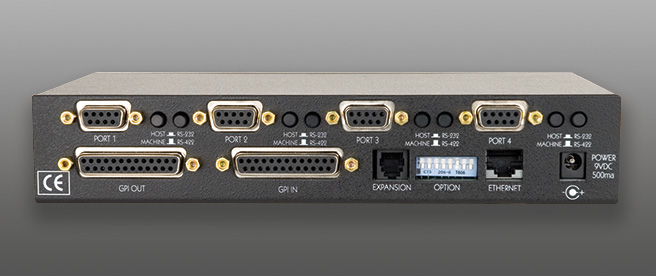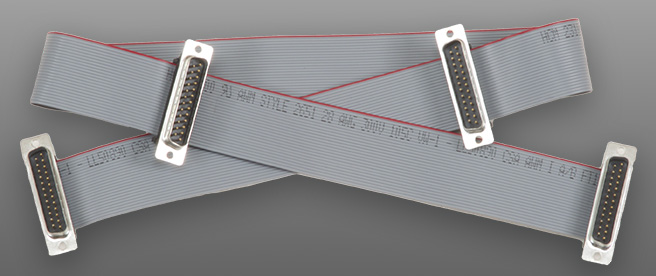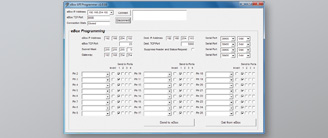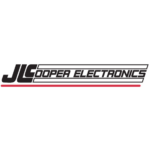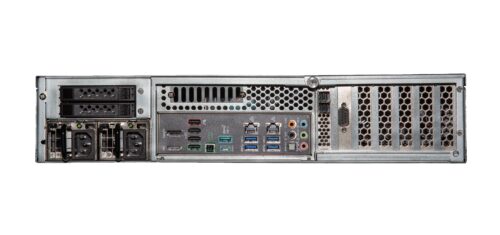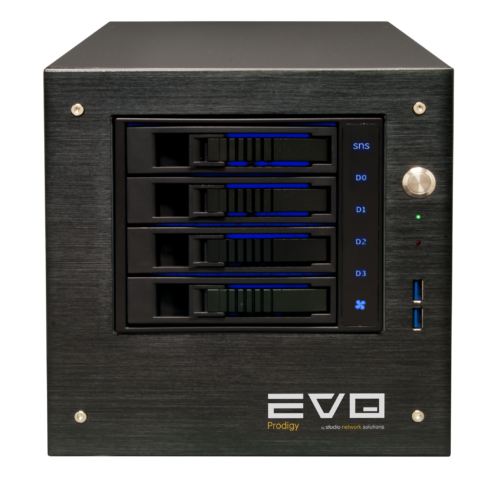Beskrivning
eBOX is a 10/100BASE-T (Ethernet) to Quad RS-232/422 (9-Pin) and GPI/Tally hardware interface.
It acts as a portal for controlling devices across your facility or across the world.
It eliminates information bottlenecks and overcomes distance limitations typically inherent to serial communication.
It simplifies long distance cabling by using IP addressable, point-to-point architecture to send control messages over existing 10/100 BASE-T wiring.
eBOX features 4 serial connectors, activity LED’s, 24 GPI Inputs and 24 GPI Outputs as a standard feature (Tally or General Purpose Interface – facilitates switch closure control).
It’s ideal for LAN, WAN and Internet control of VTRs, DDRs, switchers, computer based editing systems, cameras, projectors and other devices that use RS- 232/422 (9-Pin) and GPI.
Commands from a host NLE, Browser or RS-422 switcher/controller are directed to individual devices on the network.
This allows broadcast or networked facilities to control distant machine rooms from a facility’s central server.
eBOX is ideal for broadcast television, streaming media networks, multi-room editing facilities, news production, alert systems, monitor switching or in any audio/video/multimedia studio where remote hosts need to control devices over long distances or via the Web.
Host to eBOX, eBOX to host and eBOX to eBOX communication is possible. An unlimited number of units can be addressed.
JLCooper’s Developer Documentation provides comprehensive tools for software developers to link Visual Basic, C++, HTML or embedded devices for direct control of any device connected to any eBOX.
eBOX converts 4 serial ports and 24 GPI (General Purpose Interface and Tally) inputs and 24 GPI outputs to 100/10 baseT Ethernet.
The serial ports can be configured in the field to appear as EIA/TIA RS-232E and CCITT V.28 or as EIA/TIA RS-422A, RS- 423 and Federal Standards 1020 & 1030 ports. Additionally, the port direction can independently be configured as DTE or DCE.
eBOX is directly supported by Chyron Hego (Vidigo Live), Click Effects, Ensemble Designs (Avenue), Grass Valley, Harmonic XE, Imagine Communications, Newtek (Tricaster), Yamaha (Nuage), and other professional broadcast applications.
eBox communicates over standard TCP/IP which allows it to be used with any host computer. With TCP/ IP, traffic can be routed over internal LANs, wireless LANs, MANs, WANs and even over the Internet.
Configuration is accomplished through a software application for Mac and Windows. Items such as port speed, parity, IP address, remote IP address and TCP port are set using supplied software. Settings are stored in nonvolatile memory.
Typically, the eBOX functions as a server, passively waiting for client devices to connect to it. The device can be a computer or another eBOX configured as a client. When the eBOX is configured as a client, it will actively attempt to connect to the server eBOX. Once accomplished, eBOX will then pass data received in the serial or GPI ports to the remote eBOX. If there is no data received, eBOX will not send any TCP packets.
Ethernet
This eBOX port is just like an Ethernet port on a computer, and can be connected to a hub, switch or router.
eBOX supports IEEE 802.3u clause 28 Auto-Negotiation which automatically senses the Ethernet port speed & duplex operation and chooses the highest performance settings. Front panel LEDs indicate various operating conditions of the Ethernet connection.
Serial
The four serial ports along the top of the rear panel are 9 pin D-Sub connectors which can be configured for RS-232C or RS-422A operation.
In RS-422 mode, eBOX direction can be configured to appear as a Controller or a Device. In RS-232 mode, the eBOX appears as a DCE or DTE.
GPI
The GPI ports on the rear of the eBOX are 25 pin D-sub connectors. The GPI In connector has 24 TTL/CMOS compatible inputs with internal pull-ups to +5 volts.
The GPI Out connector has 24 TTL/CMOS compatible outputs. On both connectors, pin 1 is the ground reference and pins 2-25 are the GPI signals.
When eBOXes connected together in a client/server manner establish a connection, both client and server will send the state of its GPI In ports to each other so it can be shown on the GPI Output port on the remote eBOX.
After that, only changes to a GPI In port will cause an eBOX to send a GPI message to the remote eBOX. A packet/keep alive message is sent every 5 seconds.
GPI to Serial Converter
eBOX can act as a GPI to Serial converter. Each of the 24 GPI Inputs can be assigned to send P2 or Odetics Commands. Assignments are retained in non-volatile memory. Basic tally back information is provided via GPI outputs.
GPI/Serial to Ethernet Converter
eBOX can also work as an interface for GPI or serial. eBOX supports older P2 controllers via LAN, WAN and Internet.
Security
EBOX contains a basic security mechanism that prevents unintended hosts from passing data through a secured eBOX. A password is set on the configuration page and stored in nonvolatile memory. When password protection is enabled, eBOX embeds the password in the transmitted IP packet. At the remote end, the receiving eBOX must have password protection enabled and be programmed with a matching eBOX Rear Panel password.
eBOX Features
- Four 9-Pin D Sub Serial Connectors
- Two 24Pin D Sub GPI Connectors
- RJ-45 Ethernet Connector
- LAN, WAN or Internet Control
- Ultra Low Latency < 20 ms
- 1/2 of a single 19” Rack Space
- Use with eBOX io and sBOX
eBOX Physical Specifications
- Size 8.5 in x 4.7 in x 1.75 in
- Weight 3 lb

